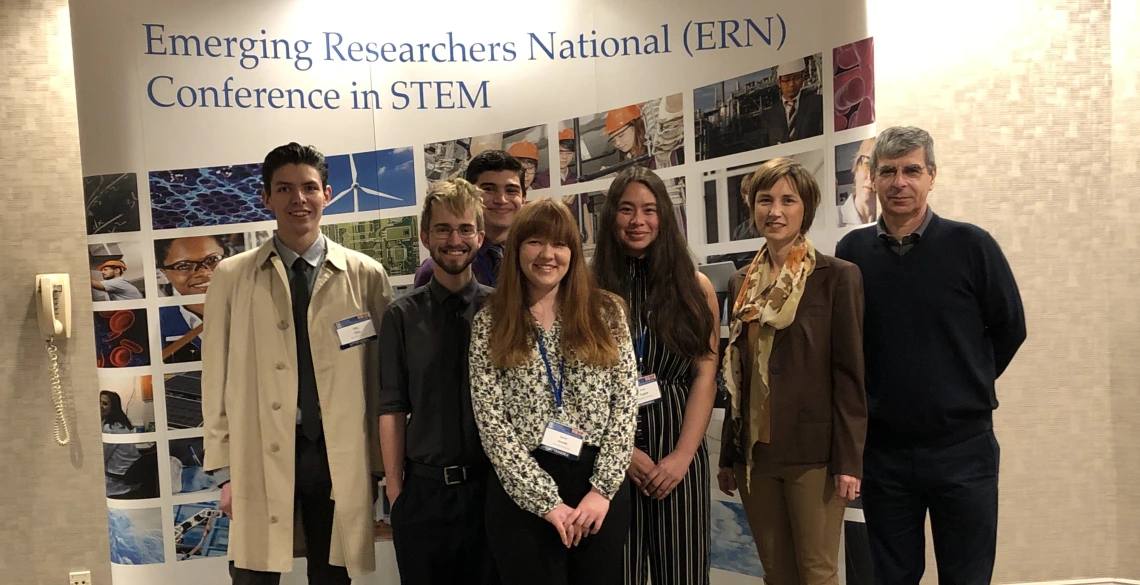Underrepresented Undergraduates Explore New Frontiers of Sound
Program provides mentors and research opportunities for underrepresented students interested in grad school and careers in engineering.

REM students Allan Chon, Trevor Lata, Justin Palacios, Rachel Gorelik and Emily English with two of their mentors, Kasi Kiehlbaugh and Pierre Deymier.
As part of a National Science Foundation-funded program, six University of Arizona undergraduates from populations underrepresented in STEM -- women, first-generation college students, and individuals from racial and ethnic minorities -- will spend the next year researching the behavior of sound waves and working with mentors as they prepare to pursue related careers and graduate degrees.
“It provided me an opportunity to do a line of work, and live in a specific kind of way that hadn’t really been available to me or anyone in my family before,” said Trevor Lata, a UA sophomore studying materials science and engineering who was in the 2019-2020 cohort. “I wanted to do engineering because I feel like there’s just such a fantastic myriad of things that can and will eventually be.”
This year marks the third cohort of students in the yearlong New Frontiers of Sound Research Experience and Mentorship, or REM, program. The experience involves a summer of research at the University of California, San Diego, followed by an academic year at the UA with mentors in the colleges of Engineering and Education. For the last two years, only UA students -- primarily in engineering -- have participated in the program. This year, the program will include four UA students and two from UCSD. Because of COVID-19, however, this year’s group, will be doing the summer portion virtually, and they are looking forward to a few added perks.
Changing the Engineering Landscape
Hispanics make up 18.3% of the U.S. population, but according to the American Society for Engineering Education, Hispanic students earned only 11.4% of engineering bachelor’s degrees in 2018. Black/African American students, who make up 13.4% of the population, earned only 4.2% of engineering bachelor’s degrees. Native Americans, 1.3% of the population, earned 0.3%. Women, who make up just over half of the U.S. population, earned only 21.9% of engineering bachelor’s degrees.
At the UA, a Hispanic Serving institution, some of these numbers are higher -- 19.7% of undergraduates in fall 2019 were Hispanic, and 27.6% were women -- this program aims to improve the numbers even further.
It’s just so rewarding and amazing to see how confident they become, and really believe in themselves, because they’re scientists, they’re engineers, they’re researchers -- they’re living it!”
Program leads at the UA are Pierre Deymier, head of materials science and engineering; Pierre Lucas, MSE professor; Sara Chavarria, assistant dean of research in the College of Education and assistant director of the STEM Learning Center; and Kasi Kiehlbaugh, director for Health Sciences Design and assistant teaching professor in biomedical engineering. Nicholas Boechler, professor of mechanical and aerospace engineering, leads the program at UCSD.
“One of the most important outcomes is keeping the students in school, making them excited about STEM research and education, and giving them the tools they need to be successful,” Chavarria said. “It’s just so rewarding and amazing to see how confident they become, and really believe in themselves, because they’re scientists, they’re engineers, they’re researchers -- they’re living it!”
Importance of Mentorship
Previous REM students say that while they initially were attracted to the research experience, the mentorship has proven invaluable. A one-unit UA course in the fall provides guidance on resume writing, job interviewing, and delivering “elevator pitches” about research. Students also get coaching on how to write a scientific paper about their research, which they present at the spring Emerging Researchers National Conference in STEM.
“The beauty of the program is that it works,” said Deymier. “One of our students, Emily English, is starting a job with Raytheon in a few weeks. Another, Rachel Gorelik, received an NSF graduate fellowship and is going on to get her PhD.”
Gorelik said the REM program solidified her decision to continue doing research in materials science and engineering.
“I’d already done research as an undergrad, but I hadn’t had an experience of working full time and being focused on one research project continuously,” said the MSE graduate who is headed to Arizona State University to pursue a PhD. “This experience confirmed that research is something I want to do full time, and I find it fulfilling and valuable.”
Going Virtual
Given that students wouldn’t be able to do research in California because of COVID-19 social distancing guidelines, coordinators considered postponing this year’s experience. But they decided the group shouldn’t have to miss out on REM. While the summer portion of the program will involve frequent virtual meetings with a team of researchers and mentors – including one REM alum! – they hope to resume in-person activities in the fall. Students will also receive an increased stipend, and the opportunity to attend an additional conference.
“This was not the right time to postpone the program,” Deymier said. “On the contrary, we need to step up the program and spend time with the students to really make sure that they stay in STEM.”

